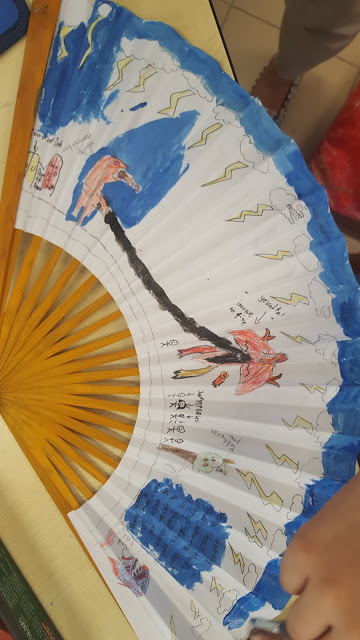The revised Bloom's taxonomy (Fig. 1) is a framework derives by Benjamin Bloom in 1956 to categorise the order of thinking skills where the tip of the pyramid display higher order thinking. With Create as a verb (Fig. 2), Art provides a platform for pupils to display acts of planning, problem solving and meaning making for improvements or radical innovations.
While there are different versions of the design process or so called thinking process. The design thinking model (Fig. 3) by d. school, as the Hasso Plattner Institute of Design at Stanford University is referenced as it's often held in high regard for how interdisciplinary design thinking and creativity can be taught.
There is no lack of information of Design Thinking when you run a search online. I was worried that Design Thinking or its counterparts such as Maker Movement or STEAM education are a fad so I read up on the following articles just to wrap my head around these ideas first. You can also sign up for an account on Coursera for this course, Tinkering Fundamentals to get started.
Related articles/ books:
 |
| Figure 1. Extracted from http://thesecondprinciple.com/teaching-essentials/beyond-bloom-cognitive-taxonomy-revised/ |
 |
| Figure 2. Extracted from https://cft.vanderbilt.edu/guides-sub-pages/blooms-taxonomy/ |
 |
| Figure 3. Design Thinking Process |
There is no lack of information of Design Thinking when you run a search online. I was worried that Design Thinking or its counterparts such as Maker Movement or STEAM education are a fad so I read up on the following articles just to wrap my head around these ideas first. You can also sign up for an account on Coursera for this course, Tinkering Fundamentals to get started.
Related articles/ books:
- Petrich, M., Wilkinson, K. & Bevan, B. (2013). It looks like fun but are they learning? PDF
- James Haywood Rolling Jr (2016) STEAM Locomotion, Art Education, 69:6, 4-5
- Don Glass & Colleen Wilson (2016) The Art and Science of Looking: Collaborative Learning Our Way to Improved STEAM Integration, Art Education, 69:6, 8-14
- Kelly Gloss & Steve Gross (2016) TRANSFORMATION: Constructivism, Design Thinking, and Elementary STEAM, Art Education, 69:6, 36-43
- Kelly W. Guyotte, Nicki W. Sochacka, Tracie E. Costantino, Joachim Walther & Nadia N. Kellam (2014) Steam as Social Practice: Cultivating Creativity in Transdisciplinary Spaces, Art Education, 67:6, 12-9
- Sarabeth erk (2016) Designing for the Future of Education Requires Design Education, 69:6, 16-20
- AnnMarine Thomas, Making Makers: Kids, Tools and the Future of Innovation. (2014) Maker Media: USA
- Wagner, T. (2012). Creating Innovators: The making of young people who will change the world. USA, New York
- Brown, T. (2009). Change by design: How design thinking transforms organizations and inspires innovation. USA: New York
- Schell, J.(2008). The art of game design: A book of lenses. Morgan Kaufmann Publishers :USA























































